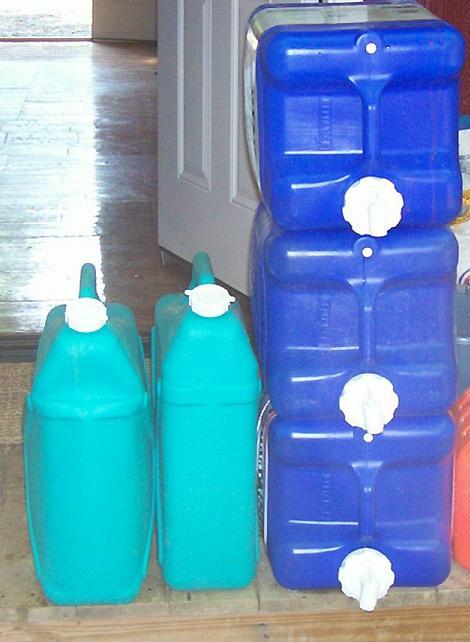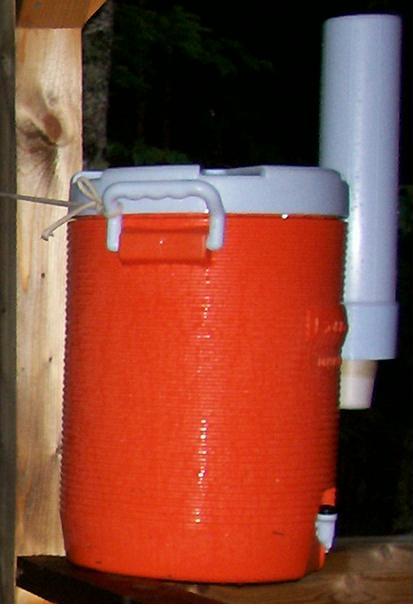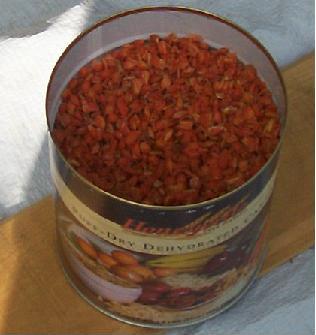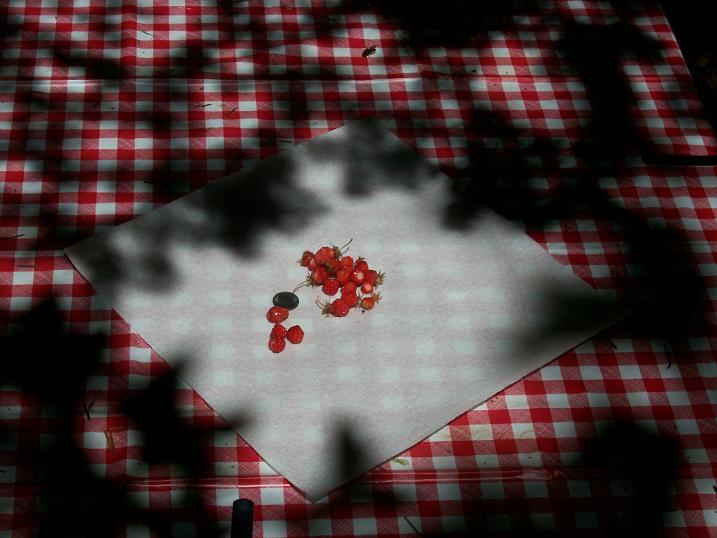
*Testing Myself - Food and Water*
When it comes to being in a post-fan situation, being prepared and having supplies is only half the battle. The other half is knowing how to pace yourself. I can honestly (and shamefully) admit I didn't. I took 60 cans of tuna with me, thinking I would be in the woods for a couple weeks. I could leave most of the tuna there when I left and be that much more prepared for the next time. As it has turned out, I am still here and going on my third month. The tuna ran out before the 2-month mark. Did I mention I really like tuna? Here's the thing, this is not a post fan situation, I can go to Sam's Club or Wal-Mart or Family Dollar to restock my supplies. But that wouldn't be an option if this were really a post fan or post economic collapse kind of thing. No worries now, but had I thought that would carry me for a season, I was way off!
Tuna wasn't the only item I underestimated. I miscalculated supplies for making bread - not that I know how - forgot to bring a cookbook, brought dehydrated foods from Honeyville Grains that I had not personally tried - only to find I didn't care for them, brought way too few light sticks, should have printed out a whole lot more articles from the rubicon than assume I would remember important little details when I needed them and severely undervalued the number of water-tight vessels I would need for the myriad of water needs I would have.
Water Containers:

Since I don't have a well and am in a tizzy about what to do to rectify that matter, I get all my water from the spring in Lee and bring it home. I started with one 7-gallon aqua-tainer and now have 3 of them, plus two 6-gallon slim containers. I'd rather have 33 gallons of water on hand than 7 any day of the week!
For the men, "tizzy" means "undecided." I have to do this on my own knowing what a pain the well was in FL and knowing I don't want to go through that again in ME - but since my property sits on a rock (Mainers call it a ledge), my "Plan A" won't work. I don't even want to talk about "Plan B." Until I find a way to make "Plan A" work, I will remain in a tizzy. In the mean time, I don't mind getting my water from the spring 15 miles away and carting it back.
Reliance 7-gallon Aqua-Tainers are top choice in my opinion. They are uniformly squared so there is no top-heaviness when full. They may slip going around corners while in the bed of a truck or on the floor of a car or van, but they are the least likely to topple and spill while in transit. And if one were to topple, it is the least likely (large) container to leak. That applies to those with very little hand strength to tighten screw-top lids - such as myself. Aqua-tainers were designed to be on their side with the included spigot. To their credit, the spigot works like most household faucets allowing a slow or fast pour. People with bad backs or mobility infirmities really need to use soda bottles or 1-gallon jugs to fill this large of a container. Of course, men of average or greater strength will argue that they are no heavier than any other 7-gallon container. So goes the battle of the sexes...
Reliance 6-gallon slim-profile containers are useful for immobile water storage. These come with an elongated spout to facilitate pouring and a small plastic cap that fits over the spout when not in use. The underside has an indentation for a handhold when tipping to pour which helps ease the process tremendously. Reliance water containers offer the advantage of a thin profile so more water can be stored in a smaller space, side-by-side. In small cottages or camps, that's a real plus. When transporting water in these, you should have a sturdy box to keep them firmly upright as the caps rarely seal tightly and the little caps for the spouts were not intended to hold back six gallons of water in the event the container should fall on it's side.
5-gallon round water bottles as are found on office water coolers around the country are excellent for storing water in a dark location. The transparency of the bottles disallow them to be stored anywhere well lit and no stored food or water should be in direct sunlight. While drinking water should always be stored away from sunlight, these bottles need the darkness more than others. There are wire shelving units designed to hold these bottles on their sides and these can certainly be used in home water storage systems as well. The downside is that they are bulky and difficult to manage. There are rarely carrying handles and they have no flat sides. Plan on securing them in place when transporting one or a few full bottles, particularly if refilling used ones without a tight seal. Although the tops can be reapplied, they do not form a lasting or secure reseal. When used as intended, on top of the cooler system, these bottles are an excellent way to have both cold drinking water and steaming hot water in one unit - assuming you have some sort of power. Otherwise, they are good only for refilling other containers with spigots to easier get a little water when you need it.
Igloo water coolers are tops for keeping cold drinking water at your fingertips any time you want it. When your camp is doing the massive oven impression, your igloo will bring your temperature back down in a hurry.

See how the outside of the igloo is covered in condensation?
That's proof the water inside is ice cold and calling my name!
Soda bottles are an excellent way to store and transport water. While households everywhere are reusing these bottles for anything that will fit through the openings, it is important to note that neither the Pepsi or Coca Cola bottling companies recommend it (see article on the subject by AFarmer here). Soda bottles were intended for one use - to hold the beverage the bottling company put into them and then to be discarded in recycle bins. Soda bottles were never intended to be used for other food storage containers by design. Since there are people who find them so useful that they prefer use these bottles anyway - myself included - be aware of the problems with long-term storage issues of these bottles for safety and know what will compromise the plastic, such as the following:
- Never store them on a surface such as concrete or gravel. Keep air flow to a maximum by placing the bottles on pallets, or milk crates so there is air flow all around the bottle.
- Never store the bottles so that they touch each other. If one bottle is compromised, it may also damage the bottle touching it - or contaminate more than one bottle's contents.
- Never store the bottles in the same proximity as toxic chemicals or cleaners, nor store any of these types of fluids or powders in the bottles.
- Keep the bottles in a constant, cool (not cold) temperature away from direct sunlight, nor in sheds or garages where the temperature may soar above 80 or drop below 40.
- Never use the bottles or any part of them to heat a food or beverage in the microwave.
Compromised plastic can compromise the safety of the product it holds. Always think safety first. Having said that, they are excellent for storing water and carrying spring water back to the camp because they are not as bulky as heavy and unyielding as the larger water containers. Even the individual serving sized bottles can serve as water storage units. Juice and cider bottles are just as good for storing or hauling water to the campsite.
Gas cans - Folks, don't do this! I could buy myself a dinner out if I had a nickle for every time someone either suggested this lunacy or I actually saw someone using a gas can for drinking water. This is a bad idea in every direction! For starters, it teaches children that gas cans contain a harmless liquid. Maybe your children understand the ones that are used for water are marked as such, but somewhere along the way, a child who can't read will think all such containers contain water. Second, it was never intended to hold food nor drinking water. Because it is so distinct in size and color, it is very possible that those containing water could accidentally be placed with those that contain gasoline. Tragic accidents happen every second of every day by generally safety-minded folks. Don't open the door to an accident waiting to happen. In the event of a fire, do you really want a well-meaning neighbor to grab a gas can in the midst of blinding smoke to save you only to find out the one he picks up is really gasoline? Please don't do it and don't let your friends do it.
If you don't think that storing water in gas cans is that big of an issue, think again! I recall an incident more than 5 years ago when I was buying hay and feed at the local feed store. In the bed of my truck, I had two full gas cans. They were secured to the side of the truck bed and I thought they would be well out of the way there. The man loading my truck untied them and said he would put these between the bales of hay. I told him I didn't think that was a good idea. He asked me what I had in them! They were clearly marked gas cans and he had to ask me what I was using them for. When I told him I kept gas in my gas cans, he said he thought everyone kept water in them! Need I say more?
Foods
Tuna - Note to self: Invest in Bumblebee and Starkist stock!
Mayonnaise - I don't think there is any such thing as too much. It's fortunate that it's easy to make if you run out - if you have the right ingredients.
Ketchup - Store twice or three times as much as you think you'll need. In a post fan event, you'll reach for this condiment to add a touch of flavor to things you might never have thought of dressing up - like tuna salad.
Spam - never overlook the obvious! It's cheap, keeps forever and when soaked overnight in water, then rinsed a few times, you can greatly reduce the amount of salt in it.
Canned Ham - It won't go to waste. Same with the spam - soak it overnight, then give it a few rinses to reduce the salt content. Works very well in a salad, can be blended with mayo for ham salad and fried or heated in a soup or stew - as well as the main meat dish.
Canned butter - One of my jars of butter got moldy. This is real butter which I canned myself back when I was living in the modern world, so it could have been something I did wrong back then. It wasn't. It was something I did wrong after opening it and being in a camp with little ventilation and even less temperature control. These jars need refrigeration after being opened. The first was fine right to the end, as was the fourth. But if I recall correctly, I used the first within a week of opening it and I used the fourth in similar fashion. All the jars were filled the same way, at the same time, from the same batch. Good info to have before the SHTF. I believe the problem was the temperature in the camp - as often the indoor heat would completely liquify the butter in the jar.
Eggs (real) - Ditch the cardboard egg cartons. Cardboard disintigrates in the event your cooler becomes more water than ice. Store and keep on hand twice as many plastic egg cartons (found in the Camping section of Wal-Mart) as you think you might use and use these to keep your eggs in an ice chest. These will snap shut and keep the eggs from falling out and they are a solid, molded plastic which would be difficult to crush or give in if something heavy were placed on top of it or more ice being added to the cooler slips out of your hand and tumbles onto the egg carton. No worries with these inexpensive alternatives to storing eggs. In all things, better to have too many than not enough.
Spaghetti / noodles - Ya can't go wrong with noodles. If you have the means to boil water, you can make spaghetti and if you can make spaghetti, you can certainly make ramen noodles. Serve with gravy, with butter, with alfredo or cheese sauce, as soup and you have a variety of meals with the same basic food. Easy to make, tastes great and stores almost forever, that's spaghetti for you.
Rice - Inexpensive, lasts nearly forever, easy to cook, easy to store, easy to transport, about twice as many things to do with it as you can do with spaghetti and is a must-have item for any pantry. Just remember not to overdo the rice or the noodles - as in all meals everyday. I understand this occurred in a great many households during the great depression. It wasn't intentional, just a matter of there not being anything else. My husband was one such victim who, as a child growing up during the depression, was served rice so many times that he refused to ever eat it again. To my knowledge, he never did. It happens. What you or your spouse really like and can eat everyday might not also be true of your children or team members. Losing a taste for a wonderful food simply because it is served all the time is a terrible way to introduce children or other team members to food storage. Keep it interesting and varied for everyone concerned.
On Honeyville Grains dehydrated foods:
Whole eggs - I freely admit I was going on the word of someone else that Honeyville dehydrated eggs were just like the real thing. Shame on me! I'm probably not the best person to make the egg comparison since I have been a poultry farmer and value the unique taste of fresh eggs. While no product can come close to farm fresh eggs, Honeyville egg powder makes a good substitute for those who have always consumed store-bought eggs. I baked with the powdered eggs and could not taste any difference with two identical recipes - the only variation being one used farm fresh eggs and the other used Honeyville whole egg powder. For my own tastes, I'll stick to the readily available farm fresh eggs and use the Honeyville powder for my baking, mixes and long-term food storage. If you make mixes for Christmas presents where the directions are on the label to make brownies or cookies, simply use Honeyville whole egg powder and adjust the directions accordingly.
Chopped onion - From an onion lover, cooking with Honeyville chopped onions is not even vaguely similar to cooking with fresh chopped onions - but you certainly don't have to worry about them sprouting if left on a counter too long. I attempted to rehydrate the Honeyville chopped onions per the package instructions and was not able to get the crispiness I had hoped to achieve for use in a fresh salad. While they do rehydrate after soaking for about 20 minutes, the texture can not compare to that of a freshly chopped onion. As long as you understand that up front, you can now use Honeyville dehydrated chopped onions in your recipes for a slightly different taste than what you would expect when using freshly chopped onions.
Strawberries - The instant you open the can, you'll think you are on a strawberry farm! When rehydrated, they do not exactly mirror the fresh strawberries you pick yourself, but the taste is every bit real strawberry! Sprinkle some onto your morning cereal right from the can and you'll never want plain cereal again. Adding them to your ice cream recipe will give you very authentic strawberry ice cream and adding to milk and whipping with a hand mixer makes a healthy beverage that much better. The only thing missing are the stems.
Blueberries - Equal to the Honeyville strawberries.
Apples - I wasn't impressed. Sure, you can add water to them to rehydrate them, but I wasn't able to reconstitute them to the texture and taste of a freshly picked apple. They tend to be chewy rather than regain that distinct crispiness I had hoped for.
Carrots - No comment. Suddenly I am reverting back to a time when I knew if I had nothing nice to say, to say nothing at all.

Potato flakes - Very good and also an excellent thickener in stews and soups to make them a bit more hearty than without it. Hard to go wrong with potato in a diet.
Fresh fruits and vegetables - Get them while you can - from roadside stands and local farmers whenever possible. Better yet, pick them wild if you can find them and know what they are. There is nothing better than wild strawberries, raspberries and indian cucumbers. Never turn down wild fruits and never buy in a store if you can get them at a vegetable or fruit stand.

Oh, and yes, I will wear a bright orange ball cap & maybe an orange bandana during hunting season.
nuckingfutz
www.alpharubicon.com
All materials at this site not otherwise credited are Copyright © 1996 - 2007 Trip Williams. All rights reserved. May be reproduced for personal use only. Use of any material contained herein is subject to stated terms or written permission.